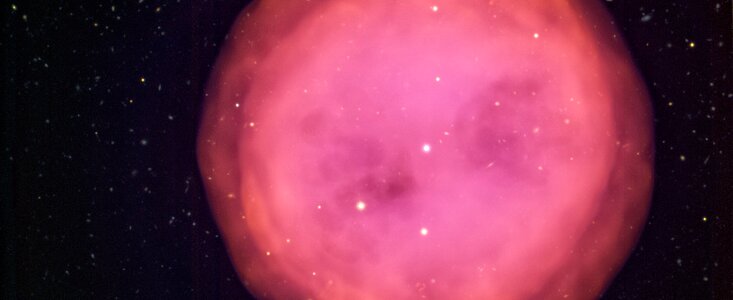A New View of the Owl Nebula: Canadian Student Imaging Contest Shines
25 Marzo 2010
A striking new Gemini Observatory image of the Owl Nebula, a prominent object visible in the northern sky, was released today (March 25, 2010) as the culmination of a nationwide student essay contest in Canada. Upon winning the award, high school student Émilie Storer from Collège Charlemagne, in Pierrefonds, Quebec, said, “I definitely want to be an astronomer now!”
Émilie was recognized at a celebration held at Collège Charlemagne in Pierrefonds, Quebec, hosted by Canadian Gemini Office Astronomer André-Nicolas Chené, as well as former Gemini Science Fellow Étienne Artigau (now at Université de Montreal). At the event, attended by over 250 students, the scientists explained how the planetary nebula formed and what is known about it from previous studies, as well as what Émilie’s new observations might bring. In addition, a live video-link to the Gemini North control room allowed students to see where the observations were made and talk to staff at the observatory.
The contest (in its fourth iteration) invites high school students from across Canada to choose their favorite object in the sky and explain in a written essay why they would like Gemini to observe it. The contest is sponsored by the team of scientists who coordinate Gemini observations for Canada (the Canadian Gemini Office), at the National Research Council of Canada’s Herzberg Institute of Astrophysics (HIA) in Victoria B.C. Four professional astronomers and science educators met to review the proposals received from almost 50 students across the country and then to select the winning entry. Created to encourage young people to participate in science activities, and particularly to become interested in astronomy, this year’s program focused on 2009 being the International Year of Astronomy.
These observations took a total of about one hour using the Gemini Multi-Object Spectrograph (GMOS) and consisted of many short exposures using a selection of four filters, to bring out specific color features in the nebula. The data were processed and stacked to produce the final image by André-Nicolas Chené who explains, “This extended and impressive nebula from the northern sky has surprisingly not been imaged much by large telescopes. Émilie’s data are now the best available set of data on this object.”
Dr. Sun Kwok, Dean of University of Hong-Kong, a world expert on planetary nebula and author of “Cosmic Butterflies, the Colorful Mysteries of Planetary Nebulae” agrees. He inspected the new data and was thrilled to be able to refine his model of this nebula thanks to the quality of the new data. "Rather than a simple ball of gas as the Owl Nebula has previously been thought to be, the Gemini images reveal that this is a bipolar nebula with a cylinder-like outer structure, and the pair of ‘eyes’ are cavities cleared out by a fast gaseous outflow. Most interestingly, the orientation of the outflow is offset from the axis of the cylinder by 36 degrees." It is expected that Émilie will be invited to be a co-author on a future article in a professional astronomy and astrophysics journal presenting these results. The GMOS image of the Owl Nebula will also be featured in the upcoming June 2010 issue of the Gemini Observatory newsletter, GeminiFocus.


